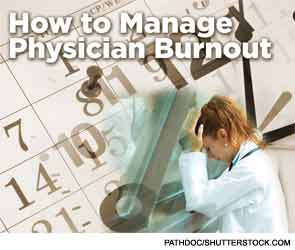
Feeling a little disillusioned about your career in medicine lately?
You’re not alone.
Many physicians are feeling burnout from today’s job pressures. It’s led 45.8% of physicians from a variety of specialties to report at least one symptom of burnout.1 Rheumatologists are not immune to that pressure.
First, there are the pressures that physicians from all specialties are facing right now. “In general, regulations are getting tighter, and revenues are shrinking,” says Stuart Kaplan, MD, of Rheumatology Consultants in Hewlett, N.Y. “We have to see more patients to make ends meet.”
New expectations with the Affordable Care Act; caring for aging and often sicker patients; and various federal initiatives, such as Meaningful Use, are adding new (and not always welcome) responsibilities, says Elyse Rubenstein, MD, a rheumatologist at Providence Saint John’s Health Center in Santa Monica, Calif.
All of these responsibilities lead physicians to spend more time doing administrative work instead of the direct care with patients that likely led them to medicine in the first place, says Mark Linzer, MD, director, Division of General Internal Medicine, Hennepin County Medical Center, Minneapolis.
Then, of course, there are electronic medical records (EMRs). Physicians in offices with a moderate amount of EMR use reported greater stress and lower job satisfaction, according to a study published this year and co-authored by Dr. Linzer.2 When EMRs were used even more, physicians felt more time pressure during patient visits, as well as more dissatisfaction and intent to leave the profession, according to the study.
“EMRs were supposed to save time, but they take more time. We’re putting in information that we don’t necessarily need to collect,” Dr. Kaplan says
.
Challenges in Rheumatology
Burnout studies identify physicians on the front line of medicine—such as family medicine, general internal medicine and emergency medicine—as the most vulnerable to burnout.1 However, rheumatology has its challenges, as well.
“Rheumatology is a cognitive specialty that requires excellent history taking and physical exam,” says Stacy Ardoin, MD, a rheumatologist with The Ohio State University Wexner Medical Center, Columbus. “Most rheumatologists enter the field because they enjoy the diagnostic art of rheumatology. The current pressures to spend less time with a patient make it more challenging to do detailed histories and exams.”
If upon exam a patient requires a biologic drug, there’s paperwork involved with that decision that can frustrate even the most levelheaded physician in the specialty. “The expense of biologic medications has heightened the pushback from insurers regarding coverage of therapies for patients, requiring doctors and staff to spend more time trying to convince insurers to cover medicines,” Dr. Ardoin says.
Additionally, “There’s no question that the significant influx of pain amplification/fibromyalgia syndrome patients into rheumatology outpatient practice has led to a major increase in job dissatisfaction,” says John A. Robinson, MD, a professor with the Department of Allergy/Immunology/Rheumatology at Loyola University Medical Center, Maywood, Ill. His practice has a blanket exclusion of this type of patient, other than MD-referred initial consultations, with the proviso that the patient returns to their primary care provider.
Treating patients with chronic conditions that don’t always have a cure can likely be exhausting for some practitioners, says John-Henry Pfifferling, PhD, director, Center for Professional Well-Being, Durham, N.C. “The aggregate of that tends to be depleting. If you expected to be in a curative domain, then you’ll have a clash of expectations,” he says.
He also says rheumatologists may feel challenged to manage patients who come to them expecting “miracle cures” from the drugs touted in ads they see on TV or in magazines—drugs that can come with significant side effects.
On the administrative side, changes and expansion to the musculoskeletal code system in the ICD-10 will require greater detail to identify and report a diagnosis more appropriately, says Dr. Rubenstein. “All of these changes may place new burdens on physicians that can lead to burnout.”
Then there are work-life balance challenges, be it managing a career along with tending to kids and aging parents or trying to carve out a thriving professional life along with finding time for outside interests. At certain times of life, this can be a more daunting task.
A December 2013 study in Mayo Clinic Proceedings reported that early career physicians were the least satisfied with their overall career choice and had the most work-home conflicts. Midcareer physicians worked more hours, took more calls at night and were the least satisfied with their specialty choice and their work-life balance. This group had the highest rate of burnout and was the most likely to leave the practice for reasons other than retirement within two years. Late-career physicians had more overall satisfaction than the other two groups.3
“Although leaving the practice of medicine may have personal benefits for the individual physician, from a societal perspective it amplifies the physician workforce shortage and may create access problems in many specialties and smaller communities,” the study authors reported, adding that the cost to replace a single physician can range from $115,000 to $587,000.
Some may think that female physicians are on a more direct path to burnout because of both career and home pressures. However, “The available research suggests that all doctors are at risk—those new to practice and decades in practice, both men and women,” Dr. Ardoin says.
“I am not certain that women will burn out earlier because of family issues,” Dr. Robinson says. “One female in our group with several children insists that family sharpens her focus while taking care of patients because she knows when she goes home, she’ll have other important issues.”
What to Do
Rheumatologists and health professionals need to stay attuned to the signs that they might be under too much stress, and take steps to counter it. In an article in Forbes, the American Psychological Association’s David Ballard, PsyD, advised:7
- Take relaxation seriously; think about what you’ll do (e.g., read, listen to music, meditate, spend time with family or friends), and set aside time to do it.
- Cultivate a rich nonwork life; find something you’re passionate about outside of work, something challenging and engaging, and do it.
- Unplug; turn off cell phones at dinner, and set a time to check your email.
- Get enough sleep; remember that fewer than six hours of sleep per night is a major risk factor for burnout.
- Get organized.
In Psychology Today, Sherrie Bourg Carter, PsyD, proposed three “out-of-the-box” ideas for beating stress:8
- Rediscover nature;
- Give back; and
- Work to resolve conflicts.
“Just as beauty is in the eye of the beholder, relaxing is in the mind of the relaxer,” says Dr. Carter.
Looking Out for Burnout
So just what does burnout look like?
Dr. Pfifferling characterizes it as a feeling of emotional exhaustion and the inability to give more to patients. This may lead the person to feel cynical and depressed. They may grieve the loss of their original expectations for their career vs. today’s realities.
“There’s a lack of a sense of personal accomplishment, and that’s associated with a desire to leave the job if not medicine altogether,” Dr. Linzer says.
Some other burnout symptoms described by Dr. Pfifferling include:
- a tendency not to set or maintain boundaries;
- always preferring to work alone;
- externalizing blame;
- having a personal identity bound up with one’s work role or professional identity;
- overloading with work, but having a hard time saying no;
- feeling guilty when you “play” or rest; and
- feeling it’s harder now to establish warmth with peers, clients and patients.
Recognizing burnout in yourself or in colleagues can be the first step to work toward treating it, Dr. Pfifferling says.
It’s also helpful to let go of unrealistic expectations. Physicians can find it useful to participate in retreats where members discuss what they do to handle unrealistic pressures in their job, says Dr. Pfifferling, whose organization specializes in helping healthcare professionals.
Medical institutions should play a role in reducing burnout, according to Dr. Linzer and co-authors in their report, “10 Bold Steps to Prevent Burnout in General Medicine.”4 This can include the use of clinician satisfaction and well-being quality indicators, incorporating mindfulness and teamwork into practice, and decreasing the stress from EMRs. For example, a study at Mayo Clinic with 74 physicians who attended paid biweekly facilitated discussion groups to incorporate mindfulness, reflection, shared experience and small-group learning found some improvement among participants.5 They felt more engaged with their work and less depersonalization.
“Some hospitals have developed novel strategies to help with the recognition of burnout and to provide doctors with tools to handle it. However, I would argue that many healthcare systems do a poor job in this regard,” Dr. Ardoin says.
Work conditions can also make a difference, Dr. Linzer says. Even with today’s increased administrative pressures, he says that burnout research encourages physicians to spend at least 10% of their time at work doing what they feel most passionate about—this could be teaching, patient care or something else. Without that outlet, burnout is likely to increase, he says.
Good ancillary staff can also help support clinicians so they don’t feel overwhelmed, Dr. Kaplan says.
Making self-care and outside interests a priority is also crucial.
“I do my best to carve out time for stress relievers: sleep, exercise, family and hobbies. I can’t say that I’m always successful,” Dr. Ardoin says.
“Time away from work with vacations can be rejuvenating and allows me to return to work ready to start again. Without steps to ensure a balanced life, I would not be as satisfied in my profession,” Dr. Rubenstein says.
Finally, always keep in mind how what you are doing helps patients, Dr. Kaplan advises. “Rheumatology is rewarding. We treat chronic diseases and now, even if we can’t cure people, we can alter their quality of life. It may be a struggle sometimes, but I feel we’re doing something useful,” he says.
Vanessa Caceres is a freelance medical writer in Bradenton, Fla.
Consequences of Burnout
So what happens if you ignore job burnout? You put your health on the line. The Mayo Clinic describes the following possible consequences:6
- Excessive stress;
- Fatigue;
- Insomnia;
- A negative spillover into personal relationships or home life;
- Depression;
- Anxiety;
- Alcohol or substance abuse;
- Heart disease;
- High cholesterol;
- Type 2 diabetes, especially in women;
- Stroke;
- Obesity; and/or
- Vulnerability to illnesses.
References
- Shanafelt TD, Boone S, Tan L, et al. Burnout and satisfaction with work-life balance among US physicians relative to the general U.S. population. Arch Intern Med. 2012;172(18):1377–1385.
- Babbott S, Manwell LB, Brown R, et al. Electronic medical records and physician stress in primary care: Results from the MEMO study. J Am Med Inform Assoc. 2014;21(e1):e100–e106.
- Dyrbyre LN, Varkey P, Boone SL, et al. Physician satisfaction and burnout at different career stages. Mayo Clin Proc. 2013;88(12):1358–1367.
- Linzer M, Levine R, Meltzer D, et al. 10 bold steps to prevent burnout in general internal medicine. J Gen Intern Med. 2014;29(1):18–20.
- West CP, Dyrbye LN, Rabatin JT, et al. Intervention to promote physician well-being, job satisfaction, and professionalism: A randomized clinical trial. JAMA Intern Med. 2014;174(4):527–533.
- Mayo Clinic Staff. Job Burnout: How to spot it and take action. Mayo Clinic Healthy Lifestyle: Adult Health. Dec. 8, 2012. http://www.mayoclinic.org/healthy-living/adult-health/in-depth/burnout/art-20046642.
- Gerry LM. 10 signs you’re burning out—and what to do about it. Forbes. April 1, 2013. http://www.forbes.com/sites/learnvest/2013/04/01/10-signs-youre-burning-out-and-what-to-do-about-it.
- Bourg Carter S. 3 uncommon strategies to manage stress. Psychology Today. Oct. 30, 2012. http://www.psychologytoday.com/blog/high-octane-women/201210/3-uncommon-strategies-manage-stress.


